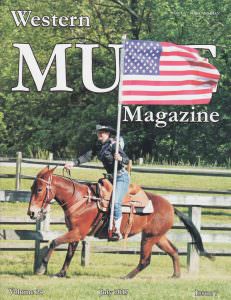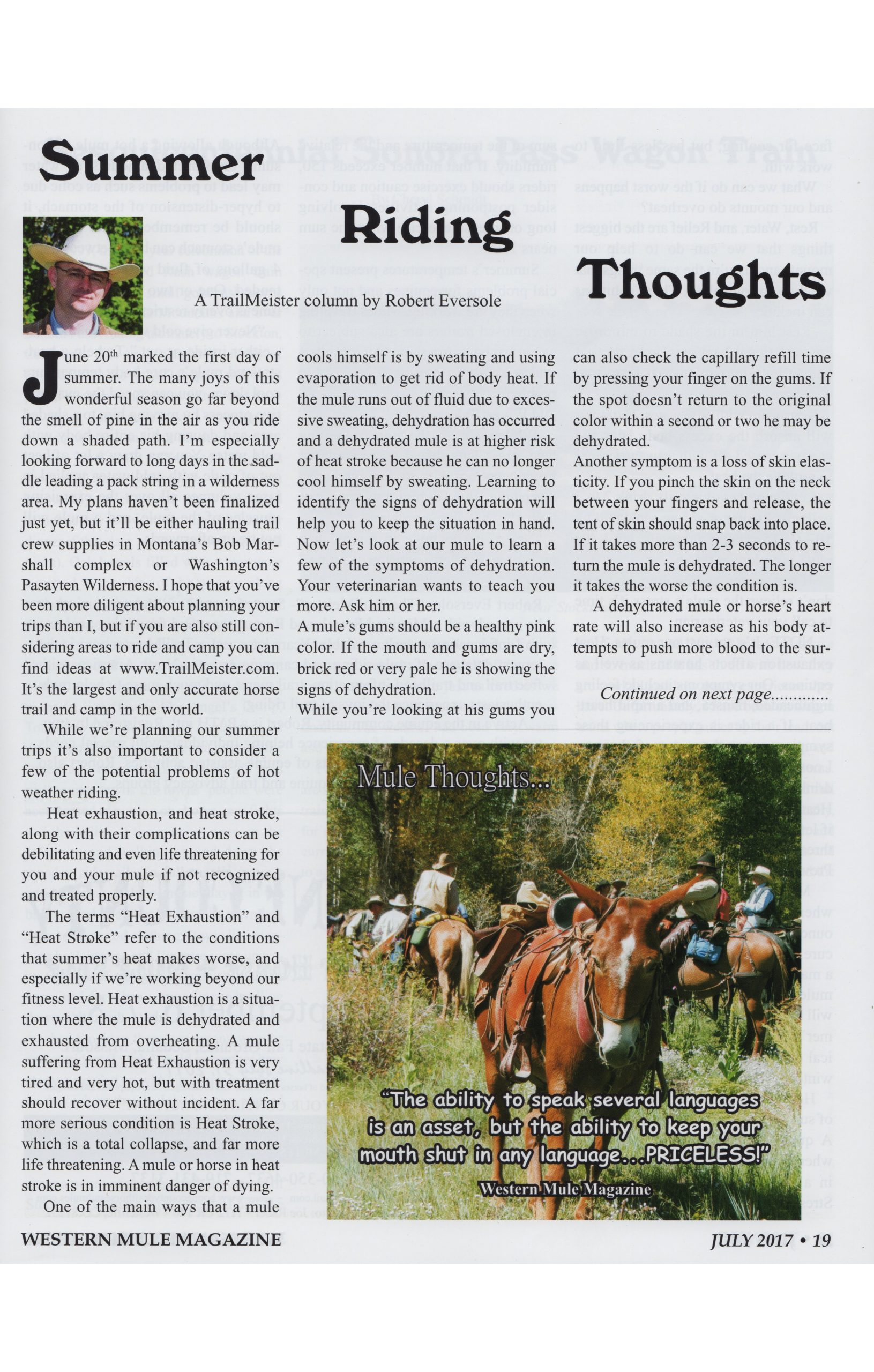 July 2017 – Summer Riding Thoughts
July 2017 – Summer Riding Thoughts
A TrailMeister column by Robert Eversole as published in Western Mule Magazine
June 20th marked the first day of summer. The many joys of this wonderful season go far beyond the smell of pine in the air as you ride down a shaded path. I’m especially looking forward to long days in the saddle leading pack string in a wilderness area. My plans haven’t been finalized just yet, but it’ll be either hauling trail crew supplies in Montana’s Bob Marshall complex or Washington’s Pasayten Wilderness. I hope that you’ve been more diligent about planning your trips than I, but if you are also still considering areas to ride and camp you can find ideas at www.TrailMeister.com . It’s the largest and only accurate horse trail and camp in the world.
While we’re planning our summer trips it’s also important to consider a few of the potential problems of hot weather riding.
Heat exhaustion, and heat stroke, along with their complications can be debilitating and even life threatening for you and your horse if not recognized and treated properly.
The terms “Heat Exhaustion” and “Heat Stroke” refer to the conditions that summer’s heat makes worse, and especially we’re working beyond our fitness level. Heat exhaustion is a situation where the horse is dehydrated and exhausted from overheating. A horse suffering from Heat Exhaustion is very tired and very hot, but with treatment should recover without incident. A far more serious condition is Heat Stroke which is a total collapse, and far more life threatening. A horse in heat stroke is in imminent danger of dying.
One of the main ways that a horse cools himself is by sweating and using evaporation to get rid of body heat. If the horse runs out of fluid due to excessive sweating, dehydration has occurred and a dehydrated horse is at higher risk of heat stroke because he can no longer cool himself by sweating. Learning to identify the signs of dehydration will help you to keep the situation in hand. Now let’s look at our horse to learn a few of the symptoms of dehydration. Your veterinarian wants to teach you more. Ask him or her.
- A horse’s gums should be a healthy pink color. If the mouth and gums are dry, brick red or very pale he is showing the signs of dehydration.
- While you’re looking at his gums you can also check the capillary refill time by pressing your finger on the gums. If the spot doesn’t return to the original color within a second or two he may be dehydrated.
- Another symptom is a loss of skin elasticity. If you pinch the skin on the neck between your fingers and release, the tent of skin should snap back into place. If it takes more than 2-3 seconds to return the horse is dehydrated. The longer it takes the worse the condition is.
- A dehydrated horse’s heart rate will also increase as his body attempts to push more blood to the surface for cooling, but has less fluid to work with.
What we can do if the worst happens and our mounts do overheat?
Rest, Water, and Relief are the biggest things that we can do to help our mounts and they’re the same things that we’d do for ourselves. These solutions can include:
- Rest him in the shade to minimize any additional heat gain from the sun and to help maximize heat loss from cool breezes.
- Douse him with cool water. The water will absorb the excess body heat and can be scraped off with a sweat scraper to remove the heat.
- Let the horse voluntarily drink 2 to 3 gallons of water at a time separated by 10- to 15-minute intervals until the horse is no longer thirsty.
If rest, water, and cooling strategies don’t relieve the horse’s stress it’s time to call your veterinarian.
NOTE: It’s not just our horses. Heat exhaustion affects humans as well as equines. Our symptoms include feeling lightheaded, nausea, and a rapid heartbeat. If a rider is experiencing these symptoms, get them out of the sun. Loosen their clothing and have them drink water. Don’t let them “ride it out.” Heat exhaustion is easily remedied, but if left untreated, it can advance to life-threatening heat stroke.
Prevention
Mr. Ben Franklin said it very well when he uttered the famous line “An ounce of prevention is worth a pound of cure.” Heat stress prevention is largely a matter of conditioning. Keeping your horse in shape through the off season will help him adjust more easily to summer’s temperatures and increased physical demands. Keep that in mind next winter.
Heat and humidity are the hallmarks of summer. But what is too hot to ride? A quick tool to help you determine when conditions may be likely to result in a heat related illness is the Heat Stress Index test. This test is simply the sum of the temperature and the relative humidity. If that number exceeds 150, riders should exercise caution and consider postponing activities involving long or intense exercise when the sum nears 180.
Summer’s temperatures present special problems for equines and not only when they are working. Horses traveling in enclosed trailers are also subject to excessive heat. Anything that inhibits a horse’s ability to cool itself can lead to problems.
Old Wives’ Tales
While we’re on the topic of treating heat stress let’s dispel some common misconceptions with studies conducted during the 1996 Olympics where it was both very hot and very humid.
“Never let a hot horse drink more than one or two swallows of water at a time.” – Although allowing a hot horse to consume unrestricted amounts of water may lead to problems such as colic due to hyper-distension of the stomach, it should be remembered that a typical horse’s stomach can hold between 2 and 4 gallons of fluid without being distended. One or two sips of water at a time is overly restrictive for a hot horse.
“Never give cold water to a hot horse – either inside or out.” – To help a heat-stressed horse’s core body temperature cool down, you can speed the evaporative process by moving him to a shaded area and dousing his entire body with cold water. You can draw a lot of heat out of horse with cold water applied in large volumes all over the exercising muscles of the horse, and horse will not tie up afterwards.


